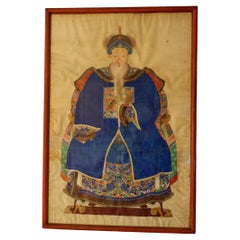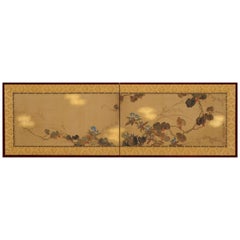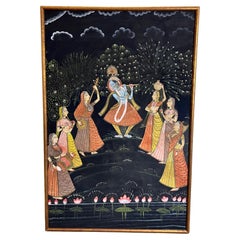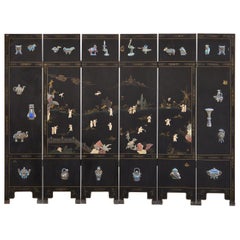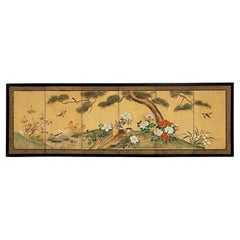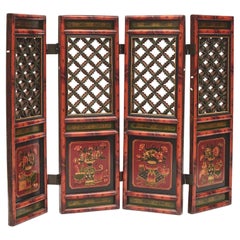Wood Paintings and Screens
to
77
526
79
690
27
8
16
14
9
8
5
5
2
2
1
1
1
70
236
384
35
113
90
29
14
3
18
3
7
12
18
12
8
1
772
768
725
538
490
616
566
330
214
39
725
712
714
23
4
2
2
2
Material: Wood
Large 19th Century Chinese Framed Ancestor Portrait, #Ric.P2
Located in Norton, MA
Hand-Painted on silk, Chinese households honor their ancestors in private family rituals, invoking their spirits for long life, health, and prosperity. Commemorative portraits, which...
Category
19th Century Chinese Qing Antique Wood Paintings and Screens
Materials
Glass, Wood, Paint, Silk
Japanese Screen Painting, Early 19th Century, Autumn Flowers by Sakai Hoitsu
Located in Kyoto, JP
A two-fold Japanese screen by the Rimpa school artist Sakai Hoitsu (1761-1828), Japan, 19th century, Edo period.
This small Japanese folding screen pai...
Category
Early 19th Century Japanese Edo Antique Wood Paintings and Screens
Materials
Wood, Silk
Large Vintage Framed Pichhavai Painting of Krishna Playing His Flute
Located in Morristown, NJ
Vintage Pichhavai painting on fabric of Krishna playing is flute with Radha and female Gopis gathered by his side. The colors, details and facial ex...
Category
1970s Indian Folk Art Vintage Wood Paintings and Screens
Materials
Fabric, Wood, Paint
Chinese Export Six Panel Cloisonné Soapstone Coromandel Screen
Located in Rio Vista, CA
Charming Chinese export six-panel lacquer coromandel screen featuring a blue and white cloisonné style border decorated with scholars objects,...
Category
20th Century Chinese Chinese Export Wood Paintings and Screens
Materials
Soapstone, Brass
Framed Chinese Hand-Painted Six-Fold Wall-Hanging from the 19th Century
Located in Austin, TX
A beautiful framed Chinese six-fold wall-hanging of silk and paper from the 19th Century, featuring a finely hand-painted landscape scene of birds and flowers.
Category
19th Century Chinese Antique Wood Paintings and Screens
Materials
Silk, Paper, Wood, Paint
A Set Of 4 Screens / Room Dividers. c 1860 - 1880
Located in Kastrup, DK
A set of 4 screens, made in elm wood. Lacquer decorated in polychrome.
Panels decorated with vases, flowers, etc.
Former screen wall from house in Shanxi pro...
Category
Late 19th Century Chinese Qing Antique Wood Paintings and Screens
Materials
Elm
Chinese Export Four Panel Gilt Lacquered Coromandel Screen
Located in Rio Vista, CA
Extraordinary Chinese export four-panel coromandel screen featuring a pagoda pavilion landscape with a dramatic gold leaf background. The black lacquered panels are incised with vibr...
Category
20th Century Chinese Chinese Export Wood Paintings and Screens
Materials
Brass, Gold Leaf
Set of Two Gilt Japanese Paintings
Located in Westwood, NJ
A set of two Japanese paintings, each with a hand gilt background depicting a Japanese Magnolia painted sans traverse across the two panels. The originals Japanese, circa 1900.
Di...
Category
21st Century and Contemporary Vietnamese Anglo-Japanese Wood Paintings and Screens
Materials
Wood, Giltwood
$2,445 / item
Japanese Painting, Framed Panel, Dahlias and Roosters, circa 1920
Located in Kyoto, JP
Tanaka Tessen (b.1890)
Dahlias and Roosters
Taisho period, circa 1920
Framed painting. Mineral pigments and ink on silk.
Dimensions (framed):
H. 159 cm x W. 97 cm x D. 2.5 cm (62.5” x 38” x 1”)
An ornate and complex composition in which the artist explores almost the entire painting surface. The coloration is bold and evocative and the tinted silk ground recreates the warm golden glow of sunset. Soft, luminous brushwork details the black feathers of the roosters, which seem to cloud and blur in counterpoint to the sharper points of the eyes and beaks. Their brilliant red combs balance the composition, echoing the rich burgundy hues of the dahlias; the flowers exquisite and lifelike. Dahlias were an exotic subject favored by painters of the Taisho era.
The painting belongs to the school of Kyoto Nihonga, exemplifying the principles of decorative elegance and consumate brush technique with which it was intimately associated. Painters of the time relied on the Shijo school method, basing the forms of the composition from life sketches. Sometimes they were then integrated with elements derived from Chinese bird and flower...
Category
1920s Japanese Taisho Vintage Wood Paintings and Screens
Materials
Wood, Silk
Antique Japanese Six-Panel Screen by Kano Chikanobu "Shushin"
Located in Prahran, Victoria
Late 17th century Kano school peony landscape screens. Both screens signed: Hogan Josen Fujiwara Chikanobu Hitsu - Kano Chikanobu (Shushin) (1660 - 1728...
Category
Early 18th Century Japanese Edo Antique Wood Paintings and Screens
Materials
Gold Leaf
Pair of Japanese Meiji Screens Blossoms of Spring, Summer and Autumn
Located in Rio Vista, CA
Amazing pair of late 19th/early 20th century Japanese Meiji period byobu screens depicting flowering plants and blossoms of the spring, summer, and autumn. Painted in the Nihonga sch...
Category
19th Century Japanese Meiji Antique Wood Paintings and Screens
Materials
Brass, Gold Leaf
Japanese Showa Two Panel Screen Blossoming Prunus Tree
Located in Rio Vista, CA
Serene Japanese Showa period two-panel folding byobu screen depicting a large spring blossoming prunus tree or plum tree. Beautifully painted with ink and natural color pigments on m...
Category
20th Century Japanese Showa Wood Paintings and Screens
Materials
Brass
Antique Chinese Two Panel Carved Painted Screen Bone Wood 1920's
Located in Douglas Manor, NY
Chinese carved wood and bone 2 panel screen
Folded size 18x36"
Category
1920s Vintage Wood Paintings and Screens
Materials
Bone, Hardwood
Byobu- Japanese Folding Screen Gold Leaf
Located in Brescia, IT
Japanese six-panel screen from the Kano school: Japanese landscape with an elegant crane.
Hand painted with mineral pigments and gold leaf inks.
The pure gold leaf is laid with great...
Category
Late 19th Century Japanese Meiji Antique Wood Paintings and Screens
Materials
Gold Leaf
Edo Period Kyoto Screen
Located in Fukuoka, JP
Edo Period Kyoto Screen
Period: Edo period
Size: 343 x 176 cm (134.6 x 69 inches)
SKU: RJ69
This stunning Edo period screen depicts typical scenes of d...
Category
18th Century Japanese Edo Antique Wood Paintings and Screens
Materials
Silk, Wood, Paper
$9,450
Antique 19th Century Japanese Two-Panel Screen ‘Byobu’, Kano School, Edo Period
Located in London, GB
Japanese Kano School Edo period two-panel screen depicting flowering prunus and bamboo on a rock formation, with colorful birds next to a body of water. ...
Category
Mid-19th Century Japanese Edo Antique Wood Paintings and Screens
Materials
Gold Leaf
Japanese Showa Four Panel Screen Autumn Flowers and Grasses
Located in Rio Vista, CA
Remarkable Japanese Showa period four-panel byobu screen depicting blossoming autumn flowers and grasses. The screen features a dramatic silver gilt square background that lends a da...
Category
20th Century Japanese Showa Wood Paintings and Screens
Materials
Brass
Magnificent And Fine Chinese Six-Panel Screen
Located in Bridgeport, CT
A six panel screen in black paint with overall gilt scrolled and carved and painted wood applied low relief decoration with some Mother-of-Pearl details. Scenes with pavilions and fi...
Category
19th Century Qing Antique Wood Paintings and Screens
Materials
Mother-of-Pearl, Wood, Lacquer
Japanese Showa Four Panel Screen Spring Flowers on Gilt
Located in Rio Vista, CA
Charming mid-20th century Japanese Showa period four-panel folding byobu screen featuring blossoming spring flowers over a bold gilt background. The painting depicts iris, camella, w...
Category
20th Century Japanese Showa Wood Paintings and Screens
Materials
Brass
Chinese Export Eight Panel Coromandel Screen Blue Mountain Pavilion
Located in Rio Vista, CA
Spectacular Chinese export eight-panel coromandel screen featuring a vibrant blue mountain landscape with pavilions and pagodas. The idyllic screen has a fertility theme decorated wi...
Category
20th Century Chinese Chinese Chippendale Wood Paintings and Screens
Materials
Brass
20th Century Japanese Six Panel River Screen
Located in Locust Valley, NY
This 20th Century Japanese Six-Panel River Screen is a beautiful example of traditional Japanese screen art, featuring a serene river scene. These ...
Category
20th Century Unknown Anglo-Japanese Wood Paintings and Screens
Materials
Wood, Paper
Gracie Studio Ming Style Lacquered Eight Panel Coromandel Screen
By Gracie
Located in Rio Vista, CA
Rare, bespoke lacquered eight-panel coromandel screen made in the Ming Dynasty style by Gracie Studio artisans in New York. Modern custom-made coromandel...
Category
20th Century American Ming Wood Paintings and Screens
Materials
Wood
Antique Framed Japanese Shunga Woodblock Print of a Couple Making Love
Located in Yonkers, NY
An antique Japanese Shunga woodblock print in gilt frame depicting a man and a woman making love. Created in Japan, this woodblock print called...
Category
19th Century Japanese Antique Wood Paintings and Screens
Materials
Glass, Wood, Paint
Evolving Elegance: An Oxidized Silver Screen from the Meiji Period
Located in Fukuoka, JP
This anodized 6-panel screen captures the serene and minimalistic beauty of a bamboo grove, embodying the aesthetic principles of the Edo period. The screen features subtle and delic...
Category
18th Century Japanese Edo Antique Wood Paintings and Screens
Materials
Silver Leaf
20th Century Chinese Coromandel Black Gilt Eight-Panel Screen Immortals Sky Gods
Located in Farmington Hills, MI
We are very pleased to offer a monumental 8ft, eight panel room divider, circa the 20th century. This beautiful double-sided hardwood screen showcases a rich, black lacquer finish an...
Category
Mid-20th Century Chinese Chinese Export Wood Paintings and Screens
Materials
Hardwood, Lacquer
Qing Dynasty Period Fretwork Four-Panel Screen with Geometric and Floral Motifs
Located in Yonkers, NY
A Qing Dynasty fretwork four-panel screen with geometric motifs and floral accents. This late Qing Dynasty period fretwork four-panel screen, crafted in the early 20th century, offers a harmonious blend of geometric precision and floral delicacy. Each of the four vertical wooden panels is adorned with meticulously arranged pierced geometric motifs, gracefully punctuated by delicate floral accents. The composition is framed by raised panels at the top and bottom, adding an element of depth and sophistication to the piece. The screen's warm honey-colored patina enhances the intricacy of the fretwork, creating a subtle yet captivating visual effect.
Perfect for adding a refined touch to any home, this four-panel screen can be used in various ways to complement your decor. Position it as an elegant room divider in a spacious living room, or use it as a decorative accent against a wall to draw the eye and add depth to the room. Its intricate patterns allow light to filter through, creating an ever-changing play of shadows that brings warmth and character to the space. With its rich historical roots and timeless design, this Qing Dynasty screen...
Category
Early 20th Century Chinese Qing Wood Paintings and Screens
Materials
Wood
Set of Four Qing Dynasty Elmwood Open Fretwork Panels with Delicate Carvings
Located in Yonkers, NY
A set of four Chinese Qing Dynasty period large carved elm wood interior door panels from the late 19th century, with fretwork design, openwork and figures in landscape scenes carved...
Category
Late 19th Century Chinese Antique Wood Paintings and Screens
Materials
Wood, Elm
17th Century Japanese Screen Pair by Soga Nichokuan, Hawks on Pine & Plum Trees
Located in Kyoto, JP
Hawks on plum and pine
Soga Nichokuan (active circa 1625-1660)
Pair of six-fold screens.
Ink, mineral pigments, gofun, gold and speckled gold l...
Category
1640s Japanese Edo Antique Wood Paintings and Screens
Materials
Wood, Paper
Large 19th Century Chinese Framed Ancestor Portrait, #Ric.P3
Located in Norton, MA
Hand-Painted on silk, Chinese households honor their ancestors in private family rituals, invoking their spirits for long life, health, and prosperity. Commemorative portraits, which...
Category
19th Century Chinese Qing Antique Wood Paintings and Screens
Materials
Silk, Glass, Wood, Paint
Vintage Four Panel Lacquer and Carved Hardstone Screen
Located in Vancouver, British Columbia
An early 20th century Asian black lacquer screen with carved coloured hardstone figures and scenery.
Category
1950s French Chinoiserie Vintage Wood Paintings and Screens
Materials
Stone
$3,960 Sale Price
20% Off
Tibetan Painting Thangka Green Tara Turquoise Gilt
Located in Somis, CA
An extraordinary hand painted Tibetan Thangka featuring the greatest compassion Goddess Green Tara. Her round face with large kind eyes, above closed lips, all flanked by long pendul...
Category
2010s Nepalese Tibetan Wood Paintings and Screens
Materials
Brocade, Wood, Paint, Paper
$775 Sale Price
50% Off
20th Century Chinese Export Six Panel Gold Leaf Coromandel Screen
Located in Rio Vista, CA
Late Qing, early republic period style Chinese export six-panel coromandel screen featuring a pavillion with figures engaged in leisurely activities on a dramatic gilt gold leaf back...
Category
20th Century Chinese Chinese Export Wood Paintings and Screens
Materials
Brass, Gold Leaf
Early 19th Century Chinese Hardwood, Lacquer and Jade Six-Panel Screen
Located in Austin, TX
A very fine mid-Qing Dynasty Chinese hardwood and lacquer six-panel screen, Jailing Period, circa 1800.
The hardwood frame inset with black lacquer panels. One side features an over...
Category
Early 19th Century Chinese Qing Antique Wood Paintings and Screens
Materials
Coral, Jade
Signed Japanese Meiji Period Table Top Screen, circa 1890
Located in San Francisco, CA
Meiji period Japanese lacquered and hand painted folding table top screen.
The bas relief (heavily textured) sculptural painting of a serene quiet nature setting in an intricately ca...
Category
Late 19th Century Japanese Meiji Antique Wood Paintings and Screens
Materials
Wood, Lacquer, Paint
Japanese Showa Four Panel Screen Mount Fuji Landscape
Located in Rio Vista, CA
Gorgeous Japanese Showa period four panel byobu screen depicting a wooded valley landscape with a rustic dwelling near mount Fuji. The screen is decorated with fantastic, vivid blue ...
Category
20th Century Japanese Showa Wood Paintings and Screens
Materials
Brass
Asian Four Individual Panel Wall Screen With Embossed Birds and Flowers
Located in Douglas Manor, NY
1763 Four individual embossed hand painted wall panels/screen
each panel 14x36"
Birds and flowers
Category
1960s Vintage Wood Paintings and Screens
Materials
Hardwood
Thangka Tibetan Painting Green Tara Hand Painted Gilt
Located in Somis, CA
An exceptional, most unique, extra long hand painted Tibetan Thangka featuring the beloved Green Tara. Seated on a high lotus throne with a pair of holy beasts, her right leg extende...
Category
2010s Nepalese Tibetan Wood Paintings and Screens
Materials
Brocade, Paint, Wood, Paper
$775 Sale Price
50% Off
Painted canvas. Toucan on a foliage background. Contemporary work.
Located in Saint-Ouen, FR
Painted linen canvas representing a toucan perched on its branch, on a foliage and gold background.
Contemporary French work.
Dimensions: H 220 x L 120 cm
Reference: LS60301260A
...
Category
20th Century French Wood Paintings and Screens
Materials
Gold Leaf
Marble 3 leaves screen
Located in grand Lancy, CH
Marble and wood screen , depicting a panther, the back is made of wood and the face is made of a small piece of marble of different color
Category
1970s European Vintage Wood Paintings and Screens
Materials
Marble
$5,200
18th Century Five-Panel Chinese Coromandel Screel
Located in CABA, AR
Transport yourself back to the opulent splendor of the 18th century with this magnificent Chinese five-panel black Coromandel screen, a true m...
Category
18th Century Chinese Chinese Export Antique Wood Paintings and Screens
Materials
Gold Leaf
$10,500 Sale Price
30% Off
Korean Four Panel Screen of Hunting Scene Joseon Dynasty
Located in Atlanta, GA
A Korean four-panel folding screen circa 1830s, from the late Joseon Dynasty. The painting depicts a vivid hunting scene on four vertical scroll panels mounted with brocade borders. The four panels are related to each other in narrative but not in an absolutely continuous fashion, therefore they could be viewed individually and independently, which was not uncommon in the screen paintings as they are meant to be folded and unfolded as needed. The pictures show a general on the far left panel seated on a low platform bed...
Category
Mid-19th Century Korean Other Antique Wood Paintings and Screens
Materials
Brocade, Wood, Paper
Hand-Painted & Gilt Decorated Chinoiserie Panels Hanging Wall Art Work
Located in Tarry Town, NY
This exquisite pair of hand-painted and gilt-decorated Chinoiserie panels showcases the intricate artistry of Chinese craftsmanship. Each black wood panel is adorned with detailed Chinoiserie scenes, depicting figures in a palace garden amidst bamboo designs, reflecting the elegance and cultural depth of traditional Chinese art. The bamboo design frames the narrative beautifully, adding a natural element that enhances the overall aesthetic.
These rectangular panels are crafted with meticulous attention to detail, ensuring that each element is rendered with precision and care. The gilt decoration adds a touch of opulence, creating a striking contrast against the black background and bringing the scenes to life. The panels' rectangular shape and dimensions are thoughtfully designed to make a bold yet refined statement in any space.
In great condition with minor wear consistent with age, these panels not only serve as a decorative piece but also as a testament to the rich artistic heritage they represent. Each panel measures approximately 44 inches tall, 25 inches wide, and 1.5 inches deep, making them a substantial and impactful addition to your wall art collection...
Category
1990s Chinese Chinoiserie Wood Paintings and Screens
Materials
Wood, Giltwood, Paint
20th Century Chinese Gilt Coromandel Eight-Panel Screen Immortals Sky Gods
Located in Rio Vista, CA
Amazing Chinese export eight-panel lacquered coromandel screen depicting a heavenly scene of immortals and sky gods floating in ruyi clouds. The fascin...
Category
20th Century Chinese Chinese Export Wood Paintings and Screens
Materials
Brass, Gold Leaf
$9,750 Sale Price
35% Off
Chinese Reverse Glass Painting of Taoist Immortals, c. 1900
Located in Chicago, IL
Popularized during the Qing dynasty, reverse glass painting requires an artist to essentially work backwards, starting with details and shading before adding color and form. Lending the finished work a subtle three-dimensional effect, this exacting technique doesn't allow for any corrections, and is only revealed to its full effect when the glass pane is turned around. This example dates to the late 19th century and depicts the Taoist immortals He Xiangu and Cao Guojiu. Said to have attained immortality through their studies of the natural world, the Eight Immortals each represent a different condition in life and impart blessings of prosperity and longevity. The charming scene is likely one of a set of...
Category
Early 20th Century Chinese Wood Paintings and Screens
Materials
Glass, Wood
18th Century Chinese Heavily Detailed 8-Panel Coromandel Screen
Located in New Orleans, LA
18th century Chinese heavily detailed 8-panel Coromandel screen, decorated on either side, with carved open work at top and bottom of each panel, heavily gold-leafed. On the front ar...
Category
18th Century Chinese Antique Wood Paintings and Screens
Materials
Giltwood
Japanese Taisho Two Panel Screen Bamboo Butterfly Landscape
Located in Rio Vista, CA
Serene Japanese late Taisho period early Showa period two-panel byobu screen featuring a colorful bamboo loquat landscape with a butterfly. Beautifully crafted in the Nihonga school ...
Category
20th Century Japanese Taisho Wood Paintings and Screens
Materials
Brass
Japanese Style Four Panel Screen Bamboo Waterfall with Magpies
Located in Rio Vista, CA
Large Chinese four panel Japanese style byobu folding screen depicting a waterfall landscape. The scene is decorated with bamboo, colorful blue magpies, and crashing waves. Construct...
Category
20th Century Chinese Showa Wood Paintings and Screens
Materials
Brass
Chinese Export Four-Panel Red Lacquer Screen, c.1900
Located in Savannah, GA
A Chinese export four-panel red lacquer screen, circa 1900.
65 inches wide (as pictured) 71 ½ inches tall by 1 inch deep
Category
Early 1900s Chinese Chinese Export Antique Wood Paintings and Screens
Materials
Wood
Japanese Screen Pair, circa 1730, Peacocks and Phoenix, Kano School
Located in Kyoto, JP
Phoenix and Peacocks.
A pair of six-panel Japanese folding screens by Tsunetake Yotei (n.d.)
First half of the 18th century.
The signature reads 67 year old Tsunetake.
The seals read:
-Tsunetake no in,
-Yotei,
-Seishin
Dimensions:
Each screen – H. 69” x W. 149” (176 cm x 378 cm)
A pair of Kano Grand Picture (Waga) screens depicting phoenix and peacocks rich with symbolic meaning. Dating to the first half of the 18th century, from the Kobikicho Kano school in Edo, this pair of folding...
Category
Early 18th Century Asian Edo Antique Wood Paintings and Screens
Materials
Gold Leaf
Large Japanese 6-panel byôbu 屏風 (folding screen) with chrysanthemum garden
Located in Amsterdam, NL
A very colourful and captivating large six-panel byôbu (folding screen) with a refined continuous painting of a luscious flower garden filled with many different types of chrysanthemums (kiku), next to a winding river.
This multi-coloured painting is set on a shiny gold-leaf background, and the chrysanthemum flowers are painted by using shell paste (gofun) in low relief.
Several clutches with a great variety of chrysanthemum flowers are in full bloom and they each show their unique form and colour. Varying from white, red, yellow and pink. The flowers bloom all around and on different kinds of bamboo fences and trellises.
In Japan chrysanthemums are believed to represent happiness, love, longevity and joy.
The panels are surrounded by two silk borders, a thin black one, and a wide brown one. The screen is protected by a black and red negoro’nuri...
Category
Late 19th Century Japanese Antique Wood Paintings and Screens
Materials
Gold Leaf
Japanese Screen Painting, circa 1700 'Horses' by Kano Tanshin
Located in Kyoto, JP
Horses
Kano Tanshin Morimasa (1653-1718)
Two-panel tea-ceremony Japanese screen or furosaki
Ink on gold leaf,
late 17th-early 18th century
Measures: H 55 cm x W 182 cm
The Kano school was closely aligned with the warrior class in Japan. The samurai, who lived in a closed and rigid hierarchical society established by the Shogunate, were drawn to the energy and freedom horses symbolize; Kano school artists commonly depicted the equine creatures as they are here, in unfettered and carefree family groups. China originally introduced horse paintings to Japan; the works typically focused on capturing the essence of horses in their various environments and often involved integrating human figures into the images.
Kano Tanshin Morimasa (1653-1718) was the son of Kano Tanyu...
Category
1690s Japanese Edo Antique Wood Paintings and Screens
Materials
Gold Leaf
Japanese Set of Two Excellent Birds And Dragonfly Shoji Doors Screens
Located in South Burlington, VT
Japan, an excellent pair/set of two (2) shoji "Birds and Dragonfly" bamboo doors or screens recently acquired from a Japanese private collector. The hand carved boards are artisti...
Category
Early 20th Century Japanese Taisho Wood Paintings and Screens
Materials
Bamboo, Wood
$796 Sale Price / set
20% Off
Fine Chinese Four-Panel Carved And Painted Room Divider Screen
Located in Bridgeport, CT
A substantial and impressive Chinese four panel low relief carved and painted room divider screen in pastel tones on black ground.
Colorful painted relief decoration on the front fe...
Category
20th Century Chinese Ming Wood Paintings and Screens
Materials
Wood
Chinese Qing Four Panel Lacquered Incised Coromandel Screen
Located in Rio Vista, CA
Rare unusual late 19th century/early 20th-century Chinese Qing four-panel coromandel screen. The front features dark red lacquer decorated with scholars objects and small landscape s...
Category
19th Century Chinese Qing Antique Wood Paintings and Screens
Materials
Brass
Chinese Antique Screen Set of 5 Cube Ming Design
Located in Somis, CA
Set of five 19th century Ming style Chinese antique window screens featuring stylized, hand-carved ruyi and small cube design. The cubes are form...
Category
19th Century Chinese Ming Antique Wood Paintings and Screens
Materials
Wood
$4,100 / set
19th C. Edo-Meiji Period Japanese Painted Five-Panel Folding Miniature Screen
Located in North Miami, FL
19th century/Edo-Meiji period japanese painted five-panel folding miniature screen
By: unknown
Material: lacquer, metal, paint, wood
Technique: carved, hand-carved, hand-painted, la...
Category
19th Century Japanese Meiji Antique Wood Paintings and Screens
Materials
Metal
Chinese six panel screen with cloisonné insets
Located in New York, NY
measurements of each panel: 16in(L) x 65.5in(H) x 1in(D); each panel is adorned with cloisonné insets, which are surrounded by delicate, finely, painted incised decorations; back of ...
Category
Mid-20th Century Chinese Wood Paintings and Screens
Materials
Enamel, Metal
Japanese Chinese Korean Asian Signed Framed Hand Painted Tiger Scroll Painting
Located in Studio City, CA
A beautiful and striking framed Asian tiger scroll painting featuring a regal tiger in the moonlight. This work is hand-painted with masterful brushstroke...
Category
Early 20th Century Japanese Showa Wood Paintings and Screens
Materials
Silk, Wood, Paint
Chinese Export Eight Panel Coromandel Screen Horse Riding
Located in Rio Vista, CA
Remarkable Chinese export eight-panel coromandel screen featuring a country landscape with men on horseback. The panels have a faded lacquer patina in a rich oxblood or cordovan tone...
Category
20th Century Chinese Chinese Export Wood Paintings and Screens
Materials
Brass
Meiji Period Silver Oxidized Screen
Located in Fukuoka, JP
Meiji Period Silver Oxidized Screen
Period: Meiji
Size: 174 x 174 cm (68.5 x 68.5 inches)
SKU: PTA107
Step back in time with this Meiji period screen, where the allure of silver ox...
Category
19th Century Japanese Meiji Antique Wood Paintings and Screens
Materials
Silver Leaf
Recently Viewed
View AllMore Ways To Browse
Japanese Red Lacquer Frame
Lattice Panel Wood
Hanging Japanese Screen
Japanese Lattice
Japanese 19th Century Meiji Period Silk Painting
Japanese Buddhist Screen
Japanese Carved Screen
Japanese Screens And Doors
Monkey Screen
Japanese Autumn Screen
Japanese Screens Six Fold
Japanese Wood Room Divider
Kyoto Silk Painting
Japanese Dragon Painting
Japanese Birds Painted On Silk
Heian Period
Japanese Crane Panel
Japanese Divider Screen
